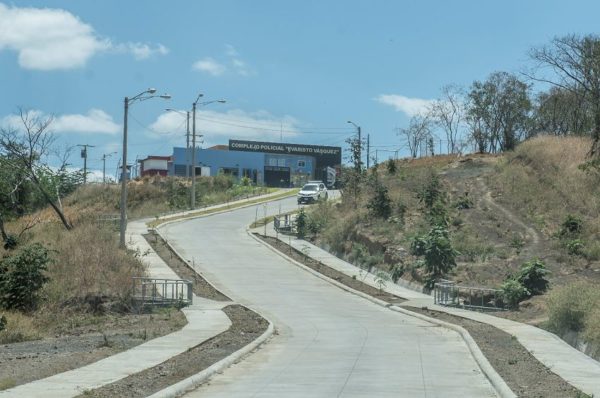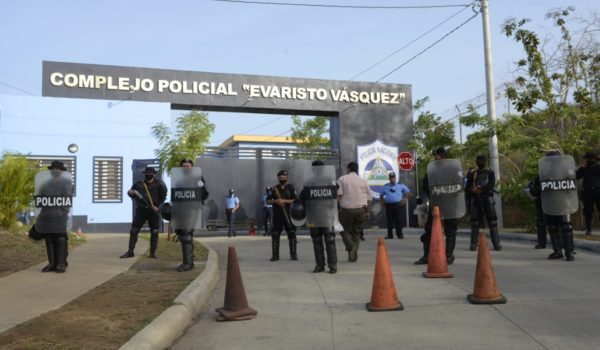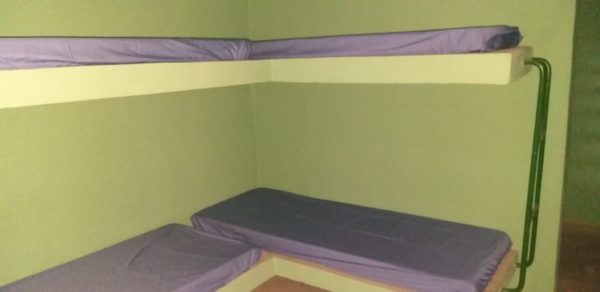The Trials that Daniel Ortega Hides

By La Prensa
HAVANA TIMES – In the El Chipote prison there are two rooms where political prisoners are accused and convicted. One big and one smaller. It’s an anomaly, lawyers say. Trials must be conducted according to the law in a judicial complex, except in situations of a humanitarian nature such as when the prisoner is ill, and the hearing must be held in the hospital.
When they come to get the political prisoner in their cell, the prisoner has no idea that they are going to trial. According to a source who requests anonymity, there is one or sometimes two police officers who arrive to take the detainee to one of the two places set up as trial rooms inside the El Chipote prison compound.
Lawyers and relatives of the political prisoners who have been present in these trials, and who demanded anonymity for fear of reprisals, describe these improvised rooms and the anomalies that occur from the beginning until the end of these processes.
The trials at the jail are marked by a pattern of violations of the constitutional and procedural rights of detainees, according to their defense lawyers and criminal law specialists.

So far, at least 18 political prisoners have faced trials at the prison; all charged with undermining national integrity. All have been convicted and eight have received sentences of between 8 and 13 years in prison.
Article 285 of the Criminal Code Procedures states that all trials, including those against political prisoners, must be public. However, admittance to the El Chipote facilities is restricted. There is no access to the media, nor to the general public and the perimeter remains surrounded by riot police.
The Big Room
The political prisoner is brought to trial at about eight o’clock in the morning. Everything usually begins at that time. The prisoner arrives with their hands behind their back, tied with zip tie handcuffs and dressed in blue.
If the detainee is under house arrest, they are transported to El Chipote for trial. That happened recently in the case of former deputy María Fernanda Flores, and it happened for the hearings of Cristiana Chamorro, Jaime Arellano and Noel Vidaurre, who are detained in their homes.
The lawyers described that the first room set up for these trials is a large auditorium.
There are two glass doors on the west side. The judge and his team enter from the one that is further north. The lawyers and the families of the political prisoners enter from the door that is further south. The police also go in and out throughout the trial through this same door.
Before entering through that door, the defense lawyers and relatives are searched at the entrance of the complex where any books or religious objects they might be carrying are taken from them and held.
“For example, I had a card of Sister (Maria) Romero. They took it from me, saying that I wasn’t allowed to go inside with it,” says one of the sources.
“Anything having to do with religion is taken away from you. Another colleague had a Rosary taken from him,” says another source. After being searched, they are taken in a vehicle to the auditorium where the trial will take place.
On the east side of the auditorium there are two other doors; the accused is brought in from the one that is furthest north.
The auditorium is large, but empty. All there is are the desks of the defense and the prosecution. There are two chairs per desk, and they are about 10 meters apart. The judge is located on a platform on the north side of the auditorium, the defense on the right and the prosecutors on the left.
The accused, along with a policeman, is placed about four meters behind the defense, and further back from there are chairs for the relatives. This way the inmates cannot talk to their lawyers or their families. “It’s impossible to speak. Anything you say, the officers in the auditorium will hear,” one of the sources explains.
The walls of this auditorium are white. There is air conditioning and bathrooms for men and women. The use of masks is mandatory as part of the protocol to prevent Covid-19 infections.
This is the same auditorium where the initial hearings against the political prisoners were held last year. “In the September hearings, every hour a policeman passed by spraying alcohol said one of the lawyers.
Something that has attracted attention in this auditorium is the presence of civilians supervising the process. “Upon entering the courtroom there is a woman at the door and another woman next to the judge, who never participate. And within the legal processes, they do not exist,” says one of the lawyers.
“Those women had nothing identifying what institution they were from. They were simply there, in plain clothes, one at the entrance and one next to the judge. In my opinion, I believe that they are government operatives who in one way or another send or bring information about something, or they are simply authorized for something, but it is not normal that they are there, “says the same lawyer.
Other lawyers asked about the presence of these women say that the women have no communication with anyone, and, at least during the trial, it doesn’t appear that they communicate with anybody present in the room.
The Small Room
The other space set up to carry out the trials is smaller. It’s like a visiting room. “It’s about 10 meters from east to west and about 14 meters from north to south. We are talking about approximately150 square meters,” says one of the lawyers.
There are no windows, no bathrooms and no air conditioning. What there is, is a fan. The walls are also white. In this room there are only two doors. The north door is where the judge, prosecutors, defense attorneys and family members enter. The south door is where the political prisoner enters. Sports commentator Miguel Mendoza is one of those who has been tried in this room.
According to our source, the building located south of that room is where the cells of the political prisoners are.
The judge sits at a makeshift desk with their team located on the east side. The defense and the prosecution, on the right and left respectively, just like in the auditorium. There are about five meters between each of the tables.
The same goes for witnesses, who are placed in front of the judge, in the center of the courtroom, with their backs to the defense and prosecutors. The majority of the witnesses are police officers, and it usually takes about seven or eight minutes for one of them to arrive once they have been called. “I’m guessing that since this is their base of operations, they must be doing their job when they send for them to testify,” speculates one of those consulted.
Although this room is small, it is still “larger than some courtrooms in the Managua courts,” says one of the lawyers.
The political prisoner is placed in a corner of the room, behind the defense with a policeman by his side. “Sometimes there are three or four officers, and most of the time there are like seven or eight crowded in. This depends on the number of prisoners, because the trials where there are up to seven accused are done in the auditorium and there are about 15 or 20 police officers who remain there throughout the trial, “says one of our sources.

Helplessness
At the beginning of the trial “the relatives and the accused are told what the trial is about. Later, during the development of the trial, when it is up to the lawyers to intervene, or simply when asking questions of the witnesses, who are policemen, that right is denied,” denounces one of the attorneys.
Lawyers mention that they are cut off when it is their time to speak or to present their arguments. The same thing happens when they try to consult with the defendants or when they want to questions to one of the witnesses. “To give an example, out of 10 attempts to ask a question, they only let me ask one. And the one they let me ask was only because I kept insisting,” our source told us.
Defendants are also not allowed to speak during the trial. In some cases, they are allowed to say a few brief words before the judge issues their ruling. “In some cases, when the trial is practically over, there is an attempt to let the accused speak, but in the end, they too are cut off. Like with the attorneys, they cut you off, they don’t let you speak. They deny you your rights,” says one of the sources.
On February 3rd, the Nicaraguan University Alliance (AUN) detailed in a statement that at one point in the trial against university leader Lesther Aleman, he intervened to point out discrepancies in the writings presented by the Public Ministry, but the prosecutor interrupted him and shouted at the judge: “Although it is his right, don’t let him speak.”
In response, the judge ordered the young university student to remain silent, said AUN. All Aleman wound up saying was “I’m innocent!”
Defendants are not allowed to speak to their lawyers. “Nor are we allowed to approach each other, no matter how much both of us request it,” says one of the political prisoners’ lawyers.
In the case of the relatives of the political prisoners, they are in the room as “listeners”. However, it wasn’t until the second day of trials that the attendance of relatives was allowed. On February 1st the relatives of Yader Parajon and Yasser Vado Gonzalez were not allowed to attend.
“Because of what we saw in the first trial -not allowing the relatives in-, we persisted. We requested that at least one family member enter the hearing, which was part of the defendant’s rights. Then we realized that they were going to allow relatives to enter the hearing, because they had called the relatives directly to tell them to appear for the trial. And that is what they do until this day, calling relatives to arrive on the day of the trial,” said one of the lawyers.
In some cases, family members have been allowed to speak with the detainees for five minutes once the trial is over. Afterwards, the lawyers and relatives are taken to the exit, while the political prisoner is transferred back to their cell. Neither lawyers nor relatives are checked on departure. If their belongings had been confiscated upon entry, they are handed back over.

Lunch time
Trials against political prisoners usually last until four or five in the afternoon, so the judge in charge orders a break for lunch. Usually between one and two in the afternoon.
“Lawyers and family members are removed from the room. Outside there are some awnings with tables and chairs for us. The defendant stays inside. We assume he eats too. We don’t actually know because they don’t allow us to enter until the assigned lunch time ends,” says one of the lawyers.
El Chipote guards allow someone to leave food for the lawyers or family member. They oversee receiving the food at the main gate and taking it to the awning where the recipients are located. About 10 or 12 people fit around the plastic tables.
Another of those consulted mentions that relatives have the option of staying in the room with the inmate at lunchtime if they do not eat. Miguel Mora’s wife, Veronica Chavez, preferred not to have lunch on the day of the trial and to share that hour with Miguel. Under police supervision, of course.





